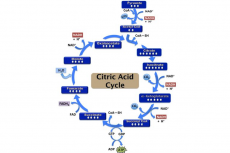

The Citric Acid Cycle
Living organisms demand a constant supply of energy for a variety of reasons but ultimately for survival. Systems have compiled in an organised and complex structure to meet those demands. The citric acid cycle holds major importance in the energy-yielding metabolic pathway that is vital for organisms to survive. Not only does the cycle provide the coenzymes that contribute to adenosine triphosphate production, but also is essential for synthesising a variety of carbon compounds. The cycle is a dominant stage in the energy-producing catabolic pathway that is conserved in all kingdoms of life. Errors in the cycle constitute a collection of unique human diseases with symptoms ranging from developmental delay, severe mental retardation, language impairment, seizures and dysmorphic facial features.
There are three important stages of cellular respiration; glycolysis, the citric acid cycle and oxidative phosphorylation. The citric acid cycle, also known as the tricarboxylic acid/ Krebs cycle is a series of chemical reactions used by most eukaryotic organisms and some prokaryotes in order to generate energy through aerobic respiration. In eukaryotes, the reaction takes place in the mitochondrial matrix, and in prokaryotes, the cytosol. This stage of respiration follows from glycolysis where acetyl-coenzyme A is used to enter the cycle to generate the production of adenosine triphosphate and NADH (reduced NAD). It is described as the ‘hub of the metabolic wheel,’ as it is an important source of the precursors needed for the storage forms of energy and for the building blocks of essential molecules. The process is highly efficient; a limited number of molecules can generate large amounts of precursor.
Glycolyis is an anaerobic process that harvests small amounts of ATP through processing glucose. It takes place prior to the citric acid cycle. Glucose undergoes phosphorylation and oxidation to form pyruvate. Pyruvate is transported into the citric acid cycle via pyruvate translocase. Pyruvate decarboxylation along with the addition of coenzyme A then takes place to make acetyl-coenzyme A. Acetyl-coenzyme A is used in the citric acid cycle to make more ATP.
The citric acid cycle is the central metabolic hub of the cell. Any molecule that can be transformed into the acetyl group (glucose, amino acids and fatty acids) can enter aerobic metabolism through the cycle. The cycle has several stages of oxidation and reduction reactions which lead to the regeneration of oxaloacetate; an important precursor to glucose. [10] The synthesis of ATP is powered by the high energy electrons that are generated by oxidation, thus the cycle functions in harvesting high energy electrons from carbon fuels.
The cyclic biosynthetic reaction maintains the cell in non-equilibrium state through the control of reactants entering the cycle and products being released. The cycle begins when acetyl CoA and oxaloacetate fuse together (catalysed by citrate synthase) to form citrate (a tricarboxylic acid) and CoA is released. The cycle is composed of a series of enzymes which change citrate. Citrate transforms into cis-aconitate and then into isocitrate.
image- https://www.thoughtco.com/citric-acid-cycle-373397

0 Comment:
Be the first one to comment on this article.